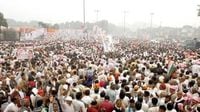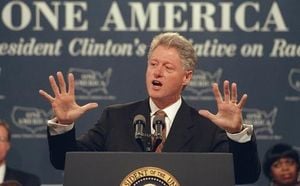Dinesh D’Souza, once hailed as the conservative movement’s most prominent Indian-American intellectual, found himself at the center of a storm this week—one that laid bare the uncomfortable realities simmering beneath the surface of the MAGA movement. On October 21, 2025, D’Souza, a bestselling author, filmmaker, and long-time defender of Donald Trump, was confronted with overt racist rhetoric from within the very ranks he had spent decades championing.
The episode began, as so many do these days, with a flurry of social media posts. After D’Souza responded to a tweet by former Republican congressman Joe Walsh—accusing Democrats of “tearing down the walls” and letting “millions of home invaders in”—a MAGA supporter, known online as Ribbert231167, fired back with a pointed insult: “You’re Indian, you made nothing, you are nothing... your existence causes me disgust.” For the first time in his forty-year career, D’Souza appeared rattled. He confessed, “In a career spanning forty years, I have never encountered this type of rhetoric. The Right never used to talk like this. So who on our side has legitimised this type of vile degradation?” (as reported by The Times of India).
For D’Souza, who emigrated from Mumbai to the United States in the 1970s and rose through the conservative establishment during the Reagan era, this moment was nothing short of jarring. He had long used his Indian-American identity as both a shield and a sword—proof, he argued, that the conservative movement was not racist. His books, such as The Roots of Obama’s Rage and 2000 Mules, made him an intellectual godfather of modern Republican grievance. Trump’s 2018 pardon of D’Souza after a campaign-finance conviction only cemented his status as a MAGA icon.
Yet, as recent events show, ideological loyalty offers little protection against the rising tide of nativism. According to The Times of India, the insult D’Souza faced is far from isolated. Over the past year, MAGA spaces have grown increasingly hostile toward Indian-Americans, with rhetoric shifting from policy concerns—like debates over outsourcing and H-1B visas—to outright racial contempt. Right-wing influencers such as Paul Ingrassia have stoked these flames, railing against what he calls the “H-1B invasion” and warning that “India is the new China.” Such language, once confined to fringe corners of the internet, now circulates freely on mainstream platforms like X and Truth Social, often amplified by verified MAGA influencers. Rarely, if ever, do movement leaders challenge these sentiments.
The true extent of this animosity was revealed in October 2025, when Politico published over 2,900 pages of leaked Telegram logs from the Young Republican National Federation—the GOP’s so-called “farm team.” The messages, as The Times of India reported, were a sewer of bigotry. Members joked about Hitler, mocked the Holocaust, and used slurs against Black, Jewish, Asian, and Indian people alike. In one exchange, a New York chapter vice-chair mocked a colleague for “dating this obese Indian woman,” to which a sitting Vermont senator, Samuel Douglass, responded, “She just didn’t bathe often.” Not a single participant objected.
This was no anonymous message board; these were the next generation of Republican staffers and strategists—the very people who will write policy and run campaigns in the future. For them, Indianness remained a punchline, despite the community’s growing prominence in American society.
Indian-Americans have long been told they are the “model minority”—hardworking, educated, and family-oriented. Trump himself courted the demographic with high-profile appointments and rallies. In his second term, Indian-Americans hold some of the most powerful roles in Washington: Tulsi Gabbard as Director of National Intelligence, Kash Patel as FBI chief, and Sriram Krishnan advising on artificial intelligence. Yet, as the leaked chats demonstrate, public praise often masks private contempt. The paradox is stark: the GOP can elevate an Indian-American to FBI Director while mocking Indians in private conversations.
This contradiction is not lost on observers. As The Times of India points out, Indian-Americans now occupy a position reminiscent of Jewish-Americans a century ago—prosperous, networked, and, paradoxically, resented for their success. With a median household income nearly twice the national average and dominance in fields like tech, medicine, and finance, Indians are highly visible in American life. That visibility, however, breeds anxiety within a movement built on nostalgia for a whiter, simpler America. When factories close, it’s not automation that gets blamed; it’s “the guy from Hyderabad.” When rents rise, it’s not hedge funds under fire, but “the IT couple from Bangalore.” In the populist imagination, every Indian success story becomes yet another sign that “real Americans” are being displaced.
Meanwhile, the Trump administration’s immigration policies have sent mixed signals to Indian professionals and students. On October 21, 2025, the U.S. Citizenship and Immigration Services clarified that existing H-1B visa holders and students already in the U.S. are exempt from the previously announced USD 100,000 H-1B visa fee—a move welcomed by thousands of Indian professionals and students. According to the Global Trade Research Initiative (GTRI), “This ensures continuity for thousands of Indian students and skilled professionals in the U.S., who can now transition to work visas without incurring exorbitant costs or leaving the country,” as reported by ANI.
Indians, who make up nearly 70% of all H-1B visa holders and 27% of international students in U.S. universities, stand to benefit significantly from this exemption. The revised rule also protects existing H-1B workers from retroactive fees and allows the Department of Homeland Security to waive costs in national interest cases. However, this relief comes with a catch: a new cap on foreign student admissions limits them to 15% of total university intake, with a maximum of 5% from any single country. For India, which sends the largest cohort of foreign students to the U.S., this sharply narrows the entry funnel for future talent.
“Trump’s parallel cap on foreign students, only 15 per cent of total students can be from abroad, and no more than 5 per cent from one country makes it harder for Indians to study in the U.S. and later get work visas,” the GTRI report warned. The two measures, they noted, “pull in opposite directions—one facilitates visa transitions for those already in the U.S., while the other tightens entry for new students.”
Frequent policy reversals under the Trump administration have only added to the uncertainty for Indian IT firms and professionals planning long-term mobility. “The volatility in U.S. immigration policy has become a greater concern than the fee itself,” the GTRI noted. While the October 21 clarifications stabilize the situation for approximately 300,000 Indian professionals currently in the U.S., the combination of student caps and unpredictable rule changes may force India’s aspiring workforce to rethink American education and career pathways.
For D’Souza and millions of Indian-Americans, these developments underscore a sobering truth: representation is not the same as respect, and proximity to power is no substitute for genuine belonging. The illusion of inclusion is easily shattered when private contempt comes to light, leaving the community to grapple with the reality that ideological loyalty cannot always buy cultural acceptance.




